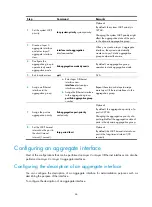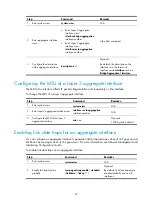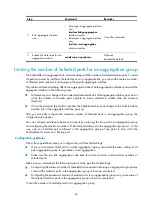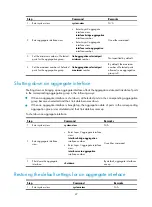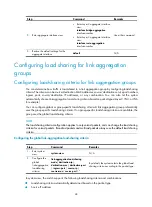
41
Configuration guidelines
•
You cannot assign a port to a Layer 2 aggregation group if any of the features listed in
is
configured on the port.
Table 6
Features incompatible with Layer 2 aggregation groups
Feature
Reference
RRPP RRPP
in
High Availability Configuration Guide
MAC authentication
MAC authentication in
Security Configuration Guide
Port security
Port security
in
Security Configuration Guide
IP source guard
IP source guard
in
Security Configuration Guide
802.1X 802.1X
in
Security Configuration Guide
Ports specified as source interfaces
in portal-free rules
Portal
in
Security Configuration Guide
•
You cannot assign a port to a Layer 3 aggregation group if any of the features listed in
is
configured on the port.
Table 7
Interfaces that cannot be assigned to a Layer 3 aggregation group
Interface type
Reference
Interfaces configured with IP addresses
IP addressing
in
Layer 3—IP Services Configuration Guide
Interfaces configured as DHCP/BOOTP
clients
DHCP
in
Layer 3—IP Services Configuration Guide
VRRP VRRP
in
High Availability Configuration Guide
Portal Portal
in
Security Configuration Guide
•
Removing an aggregate interface also removes the corresponding aggregation group. At the same
time, all member ports leave the aggregation group.
Configuring a static aggregation group
To guarantee a successful static aggregation, make sure that the ports at both ends of each link are in the
same aggregation state.
Configuring a Layer 2 static aggregation group
Step Command
Remarks
1.
Enter system view.
system-view
N/A
2.
Create a Layer 2
aggregate interface and
enter Layer 2 aggregate
interface view.
interface bridge-aggregation
interface-number
When you create a Layer 2
aggregate interface, the system
automatically creates a Layer 2 static
aggregation group numbered the
same.
3.
Exit to system view.
quit
N/A


















